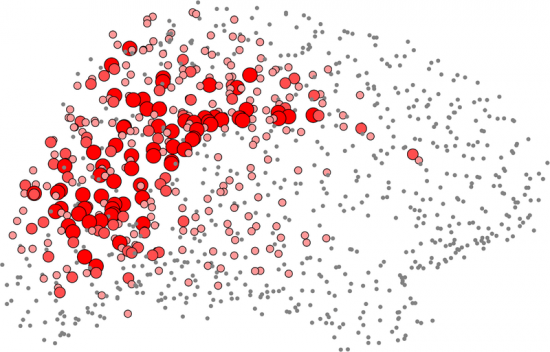Extended synaptic development may explain our cognitive edge over other primates
Cold Spring Harbor Laboratory
Source - http://www.eurekalert.org/pub_releases/2012-02/cshl-esd012712.php
Over the first few years of life, human cognition continues to develop, soaking up information and experiences from the environment and far surpassing the abilities of even our nearest primate relatives. In a study published online today in Genome Research, researchers have identified extended synaptic development in the human brain relative to other primates, a finding that sheds new light on the biology and evolution of human cognition.
"Why can we absorb environmental information during infancy and childhood and develop intellectual skills that chimpanzees cannot?" asks Dr. Philipp Khaitovich of the Chinese Academy of Sciences and the Max Planck Institute for Evolutionary Anthropology, senior author of the report. "What makes the human brain so special?"
Chimps diverged from the human lineage about 4-6 million years ago, a relatively short period of time by evolutionary standards. Yet the differences in specialized social and cultural cognitive skills between humans and chimps are striking, and much remains unknown about the biological basis.
To answer his questions, Khaitovich and an international team of researchers used microarray and RNA-sequencing technology to investigate changes in how genes are read, or expressed, during development of the postnatal brain in humans, chimps, and macaques, a more distantly related primate. And the timing of these changes may set human cognitive development apart from other primates. The group sampled the prefrontal cortex, a more recently evolved brain region associated with cognition, and the cerebellum, an ancient brain region related to motor control.
Khaitovich explained that evolutionary studies of the human brain often produce murky results, however this approach performed even better than expected, pointing them to a specific postnatal developmental process. "Among all developmental changes specific to the human brain, one process – synaptogenesis – clearly stood out." Khaitovich explained that synaptogenesis, the foundation of learning and memory in the developing brain, is characterized by the formation of synaptic connections, strengthening useful connections, and also elimination of useless connections.

Structural and functional brain imaging analyses, combined with computational analyses, reveal highly connected, centrally located regions of the human cortex (front part of the brain) that form a “structural core” of the brain. Liza Gross, Wikimedia Commons
The authors found that in humans, peak expression of synaptic genes in the prefrontal cortex is delayed until about age five, in contrast to chimps and macaques where this occurs in the first year of life. The authors noted that this human-specific change was only observed in the prefrontal cortex, and not in the cerebellum
"Our findings suggest that the human brain remains extremely plastic and susceptible to environmental input during the first five years of life," said Khaitovich. "Our study uncovers one of the important mechanisms potentially involved in evolution of human cognition."
###
Scientists from the Chinese Academy of Sciences (Shanghai, China), the Max Planck Institute for Evolutionary Anthropology (Leipzig, Germany), the Graduate School of Chinese Academy of Sciences (Beijing, China), La Trobe University (Melbourne, Australia), the Max Delbruck Center for Molecular Medicine (Berlin-Buch, Germany), and the Max Planck Institute for Molecular Genetics (Berlin, Germany) contributed to this study.
This work was supported by the Ministry of Science and Technology of the People's Republic of China, the Chinese Academy of Sciences, the Shanghai Institutes for Biological Sciences, the National Science Foundation of China, the 973 Program, the Hundred Talent program from the Chinese Academy of Sciences, the Max Planck-Society, and the Bundesministerum fuer Bildung und Forschung.
About the article: The manuscript will be published online ahead of print on Thursday, February 2, 2012. Its full citation is as follows: Liu X, Somel M,Tang L, Yan Z, Jiang X, Guo S, Yuan Y, He L, Oleksiak A, Zhang Y, Li N, Hu Y, Chen W, Qiu Z, Pääbo S, Khaitovich P. Extension of cortical synaptic development distinguishes humans from chimpanzees and macaques. Genome Res doi: 10.1101/gr.127324.111.